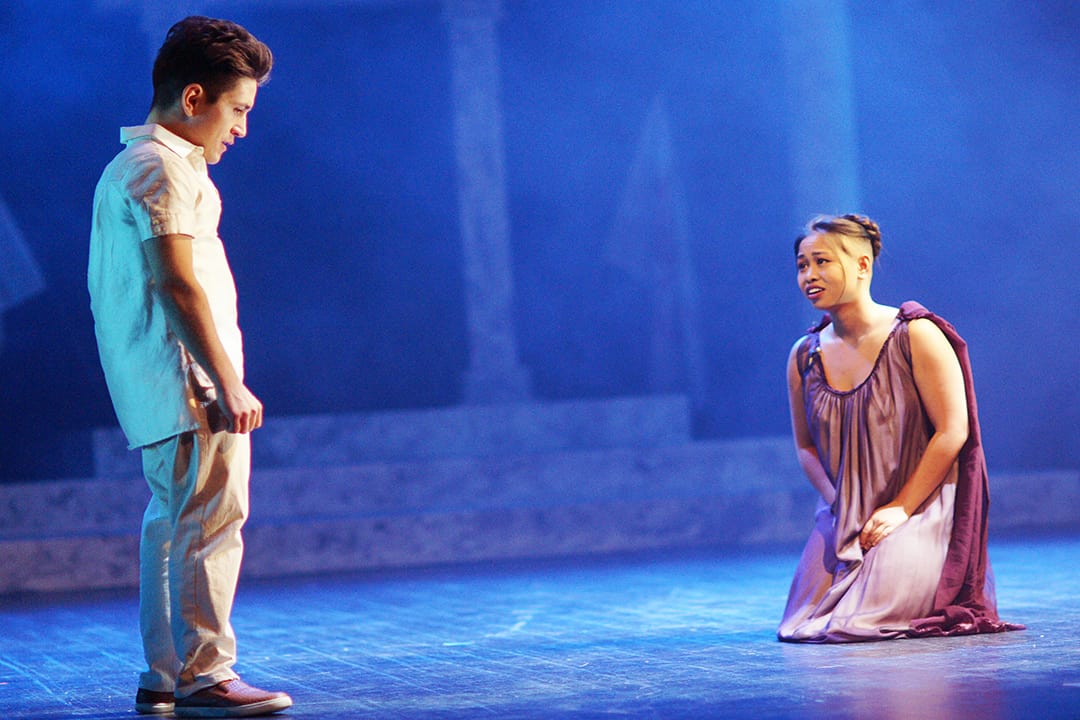Portia’s Julius Caesar at Hart House is an ambitious and honourable piece that tackles a feminist retelling of Shakespeare’s political tragedy Julius Caesar. Originally mounted this past August in Withrow Park by Shakespeare in the Ruff, director Eva Barrie returns to this text with a new cast and mostly-new crew to mount an ambitious rendition of the show.
If you are unfamiliar with Shakespeare’s Julius Caesar, here is the briefest of summaries: ancient Rome as a time of peace. Brutus (Felix Beauchamp) is invited by Cassius to join a conspiracy plot to kill Caesar for fear that he will become a dictator — they then murder Caesar! In the latter half of the play Brutus and his conspirators are faced with the consequences of their actions as Rome falls into civil war.
Yusuf Zine’s charismatic Caesar opens the night with a land acknowledgement. He laments his death, and how it might have been stopped if only we had listened to women. He continues on to satirically joke that our modern society must have no problem listening to women or Indigenous leaders, unlike his ancient Rome. The retelling focuses on this lesson, though it’s perhaps a bit nail-on-the-head.
In the play, we follow a regal Portia (Athena Kaitlin Trinh) as she navigates the politics of Rome as a woman. The play weaves between her story and that of her husband, Brutus, as Portia overhears the plot to kill Caesar and is tasked with stopping the inevitable. Portia cryptically warns her friend, Calpurnia (Whitney K. Ampadu), of what will happen to her husband, Caesar, and for a moment it seems as though they will succeed, but in one of the more jarring turns of the show Caesar changes his mind and Portia and Calpurnia’s plan fails.
In the final moments of the show Calpurnia confronts Portia, upset and betrayed that the truth of Caesar’s fate was not disclosed to her, and the two lament the ways in which their voices continue to be silenced as Rome burns around them.
Shakespeare is a great challenge for all actors, and this team rose to the occasion — standouts include JD Leslie’s poised presence as the Soothsayer, and the relationship between Trinh’s Portia and Ampadu’s Calpurnia.
Bringing ancient Rome into the cavernous hall of Hart House Theatre was an ambitious feat that the design team accomplishes to great effect. Rachel Forbes returns to the show with a deceivingly-simple set that becomes increasingly disassembled throughout the show, mirroring the crumbling peace of Rome. Julia Kim’s costumes shine vibrantly under Chris Malkowski’s supersaturated lighting.
The lighting has beautiful moments — for example, in the finale all of the design elements merge in a true moment of beauty that showcases the skills of the whole team to create a striking final image. However, certain special effects — like the fire in the finale — could be used more sparingly to create a greater impact when used. Similarly, Andy Tridarth’s sound design would also benefit from some restraint.
Further, the mix of pre-recorded and live music used throughout created a haunting ambiance that echoed through the space, but the live sounds occasionally fought with those of the actors onstage.
The most ambitious, and perhaps strongest, part of this show is the script. Portia’s Julius Caesar challenges Shakespeare and the women he wrote — or failed to write — while still paying homage to the language of the beloved bard.
Playwright Kaitlyn Riordan manages to seamlessly work in her own words, written in verse, alongside the original text to a tremendous effect. Riordan cuts down the script to keep it concise and useful, but still keeps the strongest and most iconic moments.
She also manages to slip in a few lines of one of Shakespeare’s better women monologues from another play — Hermione’s powerful words during the trial in The Winter’s Tale. For those who are familiar with our dear William’s plays, Riordan hid a few more easter-egg quotes, pulling from over 20 Shakespeare plays.
Overall, despite the fact that the show achieves much of its ambitious pursuits, certain elements don’t quite click. That being said, it’s a visually beautiful show, and the powerful final scene is well worth it.


